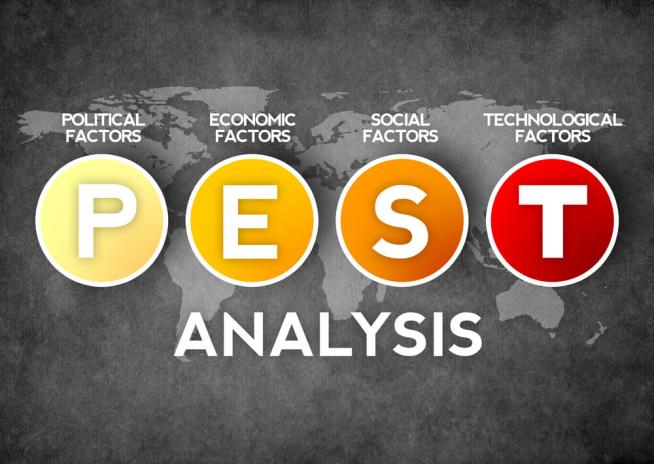PEST Analysis

What is this tool and when to use it?
PEST Analysis - stands for Political, Economic, Social and Technological- is used to assess the relation of these four external factors in relation to your business. PEST Analysis helps you determine these factors will affect your performance and activities making strategic business decisions, planning marketing activities, product development and research in a longer time. PEST Analysis is usually used in collaboration with SWOT Analysis and Porter’s Five Forces to provide a clearer understanding of the situation internally and the external factors.
How to use it?
Use the four factors of PEST Analysis and analyze your business environment and try to brainstorm the opportunities and threats that may affect your opportunities.
Step 1: Consider the Economic and Political factors
In this step, you have to consider some of the economic and political factors that may affect your business. Through the economic factors, you will study some factors such as interest rate, exchange rate, as well as inflation rate also the economic growth etc… it will also help you assess the demand, the cost of the product, the expansion and growth opportunities. As for the political factors you have to include the government regulations related to your industry, legal issues that might affect you such as copyrights, trade regulations, social and environmental policy, employment laws and safety regulations.
Step 2: Consider the social factors
In this step, you will start studying the demographic and cultural aspects as well as your target audience and the estimate of your market size. You will also include population growth, age distribution, career attitude, etc. these factors will help you examine your customers' needs and the factors that make them choose your product.
Step 3: Consider the Technological Factors
Since technology changes rapidly and your consumers will aim to own new technology, you must put into consideration the factors related to technological advancements and at which rate will this technology gets obsolete automation, and innovation etc…
Step 4: Brainstorm the opportunities and threats
Once you are done with exploring the factors that affect your business now, it’s time to take brainstorm the opportunities that can help you develop your business/ products, open new markets and help you make processes more efficient. You also have to think about the threats that might undermine your business, if you study the threats that might affect your business, you will be able to avoid these problems or minimize their impact.
Step 5: Take an action
After assessing your opportunities and threats, go ahead and take the necessary actions to grab the opportunity or avoid the threat that may affect your product.
Hints:
There are different variations of PEST Analysis that consider factors and this includes PESTLE/PESTEL, PESTLIED, STEEPLE, SLEPT, and LONGPESTLE. Each type is a mix of different factors such as Political, Economic, Socio-Cultural, Technological, Legal, Environmental and more.
Case Study:
Omar is an entrepreneur who started his own startup and wanted to analyze the risk and opportunities that his product will face. So Omar started with considering the different factors that might affect his product and he chose PEST Analysis tool since it suits his needs. Omar started with considering the factors that will affect his business.
Then he sat with the team to determine how will he take advantage of the opportunities and develop his business and how will he minimize the threats and avoid the problems. And upon that, he started to make the necessary actions in order to have a successful business.
Advantages and Disadvantages:
PEST Analysis helps you to spots business opportunities as well as gives you a hint about threats, shows you where your business in relation to the other businesses is in the same industry. Moreover, it helps you minimize the risk of failure. However, the external factors in this analysis are dynamic and are changed at a very fast pace and a certain amount of uncertainty remains after carrying out a detailed analysis. Also, its simple presentation can affect you if you don’t critically examine its impact and the findings might not seem valuable. It is sufficient for strategic planning since it only examines the external environment and ignores the internal one as well as ignore the competitive scenario.
Article Reference: Mindtools





































































EgyptInnovate site is not responsible for the content of the comments